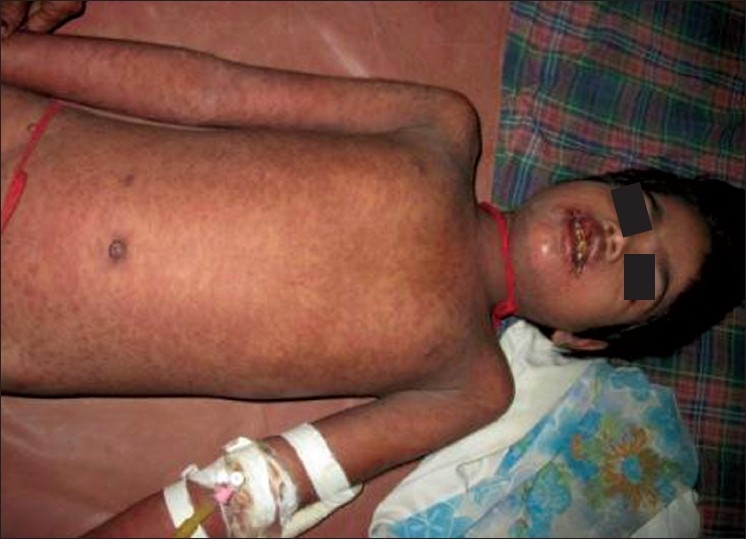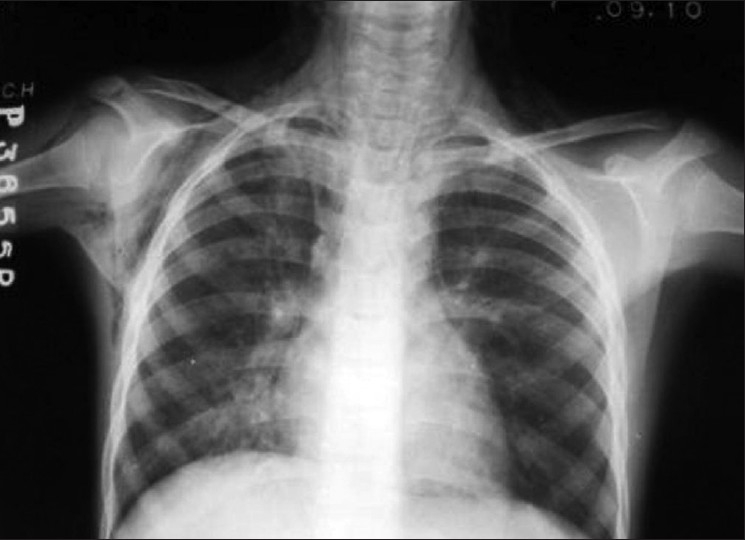Abstract
Drug rash with eosinophilia and systemic symptoms (DRESS) syndrome reflects a serious hypersensitivity reaction to drugs, and is characterized by skin rash, fever, lymph node enlargement, and internal organ involvement. So far, numerous drugs such as sulfonamides, phenobarbital, sulfasalazine, carbamazepine, and phenytoin have been reported to cause DRESS syndrome. We report a case of a 10-year-old girl who developed clinical manifestations of fever, rash, lymphadenopathy, hypereosinophilia, and visceral involvement (hepatitis and pneumonitis) after taking phenobarbital for seizures, with subsequent development of sepsis, acute respiratory distress syndrome (ARDS) and spontaneous air leak syndrome (pnemothorax and pneumomediastinum). She was put on steroids and various antibiotics and was ventilated, but ultimately succumbed to sepsis and pulmonary complications.
Keywords: Acute respiratory distress syndrome, dress syndrome, drug hypersensitivity, pneumomediastinum, pneumonia, sepsis
Introduction
Drug hypersensitivity syndrome (DHS) refers to a severe, potentially life-threatening, drug reaction. To better individualize this drug reaction, the term, Drug Rash with Eosinophilia and Systemic Symptoms (DRESS) syndrome” has recently been used. DRESS syndrome was first introduced in 1996 by Bocquet et al.[1] Skin rash and multiorgan involvement with marked eosinophilia constitute the main manifestations. The most frequently involved organ is the liver, followed by the kidney and lungs. The pathophysiology of DRESS syndrome remains unclear, but a defect in detoxification of causative drug, immunologic imbalance, and viral infections have been suggested.[2] The overall mortality in DRESS is about 10% and occurs in patients with severe multiorgan involvement.[1] Here, we present a case of a 10-year-old girl who developed DRESS syndrome after taking phenobarbital and ultimately died of multiorgan involvement with, acute respiratory distress syndrome (ARDS), pneumomediastinum and Acinetobacter sepsis.
Case Report
A 10-year-old girl presented with high-grade intermittent fever with cough for 20 days and a generalized rash for 15 days following ingestion of phenobarbital for 6 weeks. There was h/o seizures with fever from the age of 18 months, but the severity and frequency of seizures started increasing, occurring even without fever for which she was put on oral phenobarbital.
On admission, we found that the girl was toxic, febrile, icteric, with tachypnea, tachycardia, conjunctival congestion, stomatitis, and cervical, axillary and inguinal lymph node enlargement. There was a diffuse erythematous, maculopapular rash without vesiculation or blistering [Figure 1]. There were bilateral diffuse crepitations over the chest and tender hepatomegaly.
Figure 1.

Diffuse rash with oral involvement
Initial investigations showed leukocytosis, eosinophilia (absolute eosinophil count: 1586/dl), high bilirubin, elevated liver enzymes, microscopic hematuria and minimal pyuria. Imaging studies revealed hepatomegaly with features of hepatitis, mild pericardial effusion on echocardiography, and features of diffuse pneumonitis. Initial blood culture and urine culture were negative.
The patient was put on empirical antibiotics and other supportive measures. Antibiotics were changed and steroid (i.v. dexamethasone) was added on persistence of fever and dyspnea, following which there was a short period of improvement. But after a few days, the girl again complained of sudden onset exacerbation of respiratory distress and we found that she had developed subcutaneous emphysema and pneumomediastinum [Figure 2]. The patient had intermittent high spiking fever. A repeat blood culture showed growth of Acinetobacter baumanii and we switched over to sensitive antibiotics. But the general condition deteriorated and the patient developed ARDS for which she was ventilated. She improved dramatically and was extubated after 6 days. The girl again developed fever and dyspnea 2 days postextubation. There were findings of ARDS and pneumothorax on chest X-ray. She was ventilated again but succumbed after 5 days.
Figure 2.

Pneumomediastinum and subcutaneous emphysema
Discussion
A systemic allergic reaction to anticonvulsant therapy was first described in 1950 and was named “Anticonvulsant Hypersensitivity Syndrome” when associated with phenytoin therapy.[3] It has since been known as drug hypersensitivity syndrome and is now more often referred to as DRESS syndrome which is a specific, severe, idiosyncratic drug reaction characterized by skin rash with fever, facial edema, lymphadenopathy, and visceral involvement (hepatitis, pneumonitis, myocarditis, nephritis, and colitis). The diagnosis can be difficult because many of the clinical features can be nonspecific, and the syndrome often mimics infectious, neoplastic, or rheumatologic conditions.
The diagnosis of DRESS syndrome involves three criterias:[1]
Drug-induced skin eruption
Eosinophillia, Absolute Eosinophil count >1500/dl, or atypical lymphocytes
At least one of the following systemic abnormalities: enlarged lymph nodes at least 2 cm in diameter, hepatitis, interstitial nephropathy, interstitial lung disease, or myocardial involvement.
Anticonvulsants such as phenytoin, phenobarbital sodium, or carbamazepine, are the most common causes of DRESS syndrome.[4] Other drugs like lamotrigine, valproic acid, allopurinol, sulfasalazine, nonsteroidal anti-inflammatory drugs, nevirapine and vancomycin have also been associated with this syndrome.
An association between human herpesvirus 6 infection and the development of DRESS syndrome has been suggested in susceptible patients.[5]
Life-threatening multiorgan failure has been documented in DRESS syndrome; it carries a mortality rate of about 10%,[6] especially in patients who have liver involvement. But ARDS and pneumomediastinium have been reported only in a handful of cases.
The pathogenesis is believed to be a drug-induced hypersensitivity caused by abnormalities in the production and detoxification of its active metabolites. The condition is more common in slow acetylators.[7] A genetic predisposition may also exist, as evidenced by an increased risk in patients with a family history of DRESS syndrome. The syndrome may be related to epoxide hydrolase deficiency, which leads to accumulation of toxic metabolites, known as arene oxides, which may trigger an immunologic response.
Our patient was exposed to phenobarbital. Phenobarbital-induced fulminant hepatic failure in the setting of DRESS syndrome has been described.[8] To our knowledge, this is the first instance wherein pneumomediastinum, ARDS and sepsis together have been reported to develop in phenobarbital associated DRESS syndrome.
Early withdrawal of the offending medication is needed once the diagnosis is established. The recovery from this condition has been reported to be slow, lasting several weeks to months; recurrences have also been reported.[9]
Glucocorticoids remain the most widely used agents for treatment of DRESS syndrome and can result in clinical improvement, although well-controlled clinical trials are lacking. Relapse can occur during the tapering of glucocorticoids.[10] Successful use of i.v. immuneglobulin in nevirapine-induced DRESS syndrome has been reported,[11] as well as N-acetylcysteine in a patient with sulfasalazine-induced DRESS syndrome.[12]
Footnotes
Source of support: Nil
Conflict of Interest: Nil.
References
- 1.Bocquet H, Bagot M, Roujeau JC. Drug-induced pseudolymphoma and drug hypersensitivity syndrome (Drug Rash with Eosinophilia and Systemic Symptoms: DRESS) Semin Cutan Med Surg. 1996;15:250–7. doi: 10.1016/s1085-5629(96)80038-1. [DOI] [PubMed] [Google Scholar]
- 2.Sullivan JR, Shear NH. The drug hypersensitivity syndrome: What is the pathogenesis. Arch Dermatol. 2001;137:357–64. [PubMed] [Google Scholar]
- 3.Chaiken BH, Goldberg BI, Segal JP. Dilantin sensitivity: Report of a case of hepatitis with jaundice, pyrexia and exfoliative dermatitis. N Engl J Med. 1950;242:897–8. doi: 10.1056/NEJM195006082422304. [DOI] [PubMed] [Google Scholar]
- 4.lachgar T, Touil Y. The drug hypersensitivity syndrome or DRESS syndrome to Phenobarbital. Allerg Immunol (Paris) 2001;33:173–5. [PubMed] [Google Scholar]
- 5.Descamps V, Valance A, Edlinger C, Fillet AM, Grossin M, Lebrun-Vignes B, et al. Association of human herpesvirus 6 infection with drug reaction with eosinophilia and systemic symptoms. Arch Dermatol. 2001;137:301–4. [PubMed] [Google Scholar]
- 6.Ghislain PD, Roujeau JC. Treatment of severe drug reactions: Stevens-Johnson syndrome, toxic epidermal necrolysis and hypersensitivity syndrome. Dermatol Online J. 2002;8:5. [PubMed] [Google Scholar]
- 7.Rieder MJ, Shear NH, Kanee A, Tang BK, Spielberg SP. Prominence of slow acetylator phenotype among patients with sulfonamide hypersensitivity reactions. Clin Pharmacol Ther. 1991;49:13–7. doi: 10.1038/clpt.1991.3. [DOI] [PubMed] [Google Scholar]
- 8.Syn WK, Naisbitt DJ, Holt AP, Pirmohamed M, Mutimer DJ. Carbamazepine-induced acute liver failure as part of the DRESS syndrome [published correction appears in Int J Clin Pract.2005;59:1371] Int J Clin Pract. 2005;59:988–91. doi: 10.1111/j.1368-5031.2005.00550.x. [DOI] [PubMed] [Google Scholar]
- 9.Valencak J, Ortiz-Urda S, Heere-Ress E, Kunstfeld R, Base W. Carbamazepine-induced DRESS syndrome with recurrent fever and exanthema. Int J Dermatol. 2004;43:51–4. doi: 10.1111/j.1365-4632.2004.01832.x. [DOI] [PubMed] [Google Scholar]
- 10.Kaminsky A, Moreno M, Diaz M, Charas V, Bravo G, Kien C. Anticonvulsant hypersensitivity syndrome. Int J Dermatol. 2005;44:594–8. doi: 10.1111/j.1365-4632.2004.02233.x. [DOI] [PubMed] [Google Scholar]
- 11.Fields KS, Petersen MJ, Chiao E, Tristani-Firouzi P. Case reports: Treatment of nevirapine-associated dress syndrome with intravenous immune globulin (IVIG) J Drugs Dermatol. 2005;4:510–3. [PubMed] [Google Scholar]
- 12.Gabay C, De Bandt M, Palazzo E. Sulphasalazine-related life-threatening side effects: Is N-acetylcysteine of therapeutic value? Clin Exp Rheumatol. 1993;11:417–20. [PubMed] [Google Scholar]


